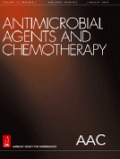Autores: Nicoletti AG, Marcondes MF, Martins WM, Almeida LG, Nicolás MF, Vasconcelos AT, Oliveira V, Gales AC.
Publicação: Antimicrobial Agents and Chemotherapy • DOI: 10.1128/AAC.00158-15 • 8 June 2015
Abstract:
Three Klebsiella pneumoniae clinical isolates demonstrating carbapenem resistance were recovered from different patients hospitalized at two medical centers in São Paulo, Brazil. Resistance to all β-lactams, quinolones, and some aminoglycosides was observed for these isolates that were susceptible to polymyxin B. Carbapenem hydrolysis, which was inhibited by clavulanic acid, was observed for all K. pneumoniae isolates that belonged to the same PFGE and a novel ST1781 (CC442). A 10Kb non-conjugative IncQ plasmid, denominated p60136, was transferred to Escherichia coli TOP 10 by electroporation. The full sequencing of p60136 showed that it was composed by a mobilization system, an ISKpn23, a phosphotransferase aph3A-VI, and a 941pb open reading frame (ORF) that codified a 313 amino acid protein. This ORF was named blaBKC-1. BKC-1 (Brazilian Klebsiella Carbapenemase-1) showed a pI of 6.0 and possessed the highest identity (63%) with a β-lactamase of Sinorhizobium meliloti, an environmental bacteria. Hydrolysis studies demonstrated that purified BKC-1 not only hydrolyzed carbapenems, but also penicillins, cephalosporins, and monobactams. However, the carbapenems were less efficiently hydrolyzed due to their very low kcat values (0.0016-0.031 s-1). In fact, oxacillin was the best substrate for BKC-1 (kcat/KM, 53522.6 mM-1.s-1). Herein, we report a new class A carbapenemase, confirming the diversity and rapid evolution of β-lactamases in K. pneumoniae clinical isolates.
